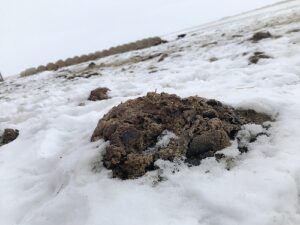Cost of Manure Management

Manure, when used properly, is a valuable resource for the cropping or forage sectors, but handling it comes with a cost. While many producers extensively winter feed their cattle which reduces or eliminates the cost and time associated with manure removal, hauling and application, this article discusses traditional management of livestock manure.
The traditional management of livestock manure involves removal from drylot pens each spring to be utilized as fertilizer on crop or pasture, in either raw or composted form. The application of manure has short-term and long-term effects on crop yields. In the short term, the addition of nutrients (such as nitrogen) in manure may immediately increase yields. In the long-term, increases in yields may be due to delayed nutrient release or improvements in soil quality as the result of a series of complex interactions between the nutrients, organic matter and organisms in the manure and the existing conditions of the soil.
When discussing the cost-benefit of manure versus commercial fertilizers, previous studies have traditionally focused on the short-term effects. As manure contains lower concentrations of key nutrients than commercial fertilizers, the cost of manure handling is a key factor for determining whether manure is providing a cost-effective fertilizer resource compared to commercial fertilizers. An important question is what is the break-even hauling distance for manure to be cheaper than using commercial fertilizer? Research addressed this question by measuring crop response data relative to the application of manure and by using custom application rates in Saskatchewan. This study found that beef manure could be hauled anywhere from 1.0 to 7.9 km. The two key factors to explain the wide range were: (1) variable soil conditions, and (2) varying nutrient content of the manure. An Alberta study (2006) estimated that beef feedlot manure can be hauled economically from 4.99 to 18.82 km depending upon phosphorus availability and nutrient content. The same study found the estimated total cost (including loading, hauling and spreading) for applying solid manure ranged from $3/tonne (with radius of haul < 1.6 km) to $8/tonne (with radius of haul < 8 km).
The wide range of the break-even hauling distance found in these studies shows that the evaluation of the economics of manure as a fertilizer depends on: nutrient content of the manure, type of crop, soil condition, the cost of transport, form of manure (e.g. liquid, slurry, solid) as well as the market value of manure relative to commercial fertilizer. All of these variables are important information to estimate the economic hauling distance for a specific farm.
Information on manure management and decision-making tools have been developed by provincial departments of Agriculture and are publicly available on their websites. |
|---|
|
According to the Statistics Canada’s 2017 Farm Management Survey, only 57% of beef operations reported spreading manure on their forage crops each year, and 63% on their field crops across Canada. These are among the lowest adoption rates across all farm types. While management costs, in particular the short cost-effective hauling distance, may be one of the key limiting factors for manure application, more information on the long-term benefits of adding manure to the soil could increase adoption rate. Studies have shown that the use of animal manure as a soil amendment can have profound effects on soil structure, soil chemistry and soil organisms (microbes and macrofauna), and suppress soil pathogens and disease. Strategic management of animal manures may be a cost-effective way in the long-run to increase soil organic matter content, stimulate soil biology, improve physical structure and ultimately improve crop yields.
While manure application is beneficial to soil in many ways, there are potential environmental concerns such as nutrient loading and water quality issues, which can be minimized through careful attention to application rate and timing. It should also be noted that there are different regulations about manure application and seasonal restrictions across provinces.
| Provincial Guidelines/Regulations |
|---|
|
Learn More:
- What Happens When the Manure Hits the Field? (BCRC Blog)
- Manure and Nutrient Management (BCRC webpage)
- Rules, regulations & restrictions: How to navigate manure management policies, The Western Producer, 2014.
- References
- Graham, E., Grandy S., Thelen, M. Manure effects on soil organisms and soil quality. Emerging Issues of Animal Agriculture. Available here.
- Jungnitsch, P. F., Schoenau, J. J., Lardner, H. A., & Jefferson, P. G. (2011). Winter feeding beef cattle on the western Canadian prairies: Impacts on soil nitrogen and phosphorus cycling and forage growth. Agriculture, ecosystems & environment, 141(1-2), 143-152. Available here.
- Nagy, C. N. (1999, February). Economic returns and hauling distance of hog and cattle manure. In Soils and Crops Workshop. Available here.
- Toma and Bouma Management Consultants. (2006) Economic analysis of soil phosphorus limits on farms in Alberta . In Alberta Soil Phosphorus Limits Project. Vol 4: Economics and management. Alberta Agriculture, Food and Rural Development, Lethbridge, Alberta, Canada. 82pp.
Click here to subscribe to the BCRC Blog and receive email notifications when new content is posted.
The sharing or reprinting of BCRC Blog articles is welcome and encouraged. Please provide acknowledgement to the Beef Cattle Research Council, list the website address, www.BeefResearch.ca, and let us know you chose to share the article by emailing us at info@beefresearch.ca.
We welcome your questions, comments and suggestions. Contact us directly or generate public discussion by posting your thoughts below.